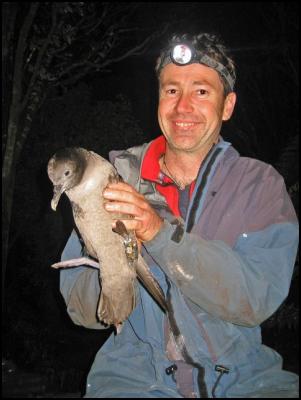Muttonbirds pursue endless summer across Pacific
8 August 2006 ***
Muttonbirds pursue endless
summer across Pacific

It's an epic journey for a small bird. A team of scientists from New Zealand, the US, and France has discovered that sooty shearwaters (known to Kiwis as muttonbirds or titi) make a 64 000 km round trip each year, chasing summer across the Pacific.
'This is the longest animal migration recorded via an electronic tracking device', says Paul Sagar, a seabird biologist at the National Institute of Water & Atmospheric Research, who took part in the study. The results will be published online in the prestigious American journal Proceedings of the National Academy of Sciences in the week beginning 7 August.
Sooty shearwaters are one of the most abundant seabirds in the world, but populations are declining. Following their movements could help shed light on the causes of this decline, thought to be linked to climate change and entanglement in fishing gear. But tracking a bird that spends 90% of its time at sea isn't easy.
Recent developments in technology are now enabling scientists to track birds as small as sooty shearwaters, which are about the size of a small seagull. For this study, the team used small light-sensitive electronic tags to follow the migration of 19 sooty shearwaters from breeding colonies on Whenua Hou (Codfish Island) and Mana Island, New Zealand. The tags used light and temperature levels to record each bird's location every day over a migration period lasting several months.
All the tagged birds followed a figure-of-eight pattern across the Pacific, crossing between southern and northern hemispheres in pursuit of an endless summer. Each bird covered an average of about 64 000 km in 200 days, covering distances of up to 910 km per day.
Scientists previously thought that the birds spent the northern summer roaming around the north Pacific. This study revealed that, instead, the birds remain in one of three areas – off Japan, Alaska, or California. This finding has implications for muttonbird conservation, as levels of fishing and ocean productivity are different in these three areas.
'This extraordinary migration probably allows muttonbirds to feed in nutrient-rich waters throughout the Pacific', says Mr Sagar. Because they range so widely, and are at the top of the food chain, muttonbirds may make good indicators of climate change and ocean health.
'Rakiura Maori are excited with the results of this research into their Taonga', says Tane Davis, chairman of the Rakiura Titi Island Administrating Body, who supported this study. This type of collaborative research supports one of the many objectives of the Kia Mau Te Titi Mo Ake Tonu Atu research project.
ENDS


 Fix & Fogg: NASA Hand-picks Kiwi Nut Butter Brand To Travel To Space In NZ First
Fix & Fogg: NASA Hand-picks Kiwi Nut Butter Brand To Travel To Space In NZ First Citizens of the Sea: Sailors To Revolutionise Our Understanding Of Pacific Biodiversity
Citizens of the Sea: Sailors To Revolutionise Our Understanding Of Pacific Biodiversity Netsafe: Making A Splash With Online Safety: Netsafe Launches New Flagship Programme For Kids
Netsafe: Making A Splash With Online Safety: Netsafe Launches New Flagship Programme For Kids NZGBC: Flood Resilience PhD Student Widi Auliagisni Named Future Thinker Of The Year 2024
NZGBC: Flood Resilience PhD Student Widi Auliagisni Named Future Thinker Of The Year 2024 Business Canterbury: European Free Trade Agreement A Game-changer For Canterbury
Business Canterbury: European Free Trade Agreement A Game-changer For Canterbury Business Canterbury: Urges Council To Cut Costs, Not Ambition For City
Business Canterbury: Urges Council To Cut Costs, Not Ambition For City



